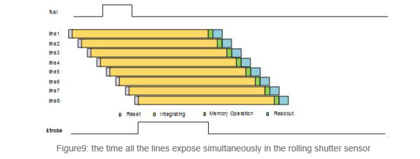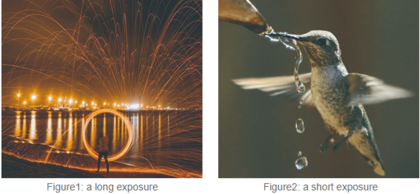Rolling shutter versus global shutter cameras

Rolling shutter is used to capture still images, and global shutter is used to capture moving objects. Particularly for resolutions greater than 1.6 Megapixels, a rolling shutter camera is less expensive. For instance, the MER2-1220-32U3C 12MP rolling shutter camera costs under 300 dollars. On the other hand, our 12MP global shutter (ME2P-1230-23U3C) costs over 1000 dollars. Compared to a rolling shutter camera, a global shutter has a larger sensor because of its larger pixels. Consequently, a global shutter camera captures images with greater clarity and sensitivity to light.
Exposure and shutter
The shutter's exposure time is the amount of time it is open to closed. Photoelectric effect and light exposure on the chip's photosensitive array happen during this time. Subsequently, photoelectric charges are generated. The grayscale value of each pixel is shown by the A/D transformation. The longer the shutter is open and the longer the exposure time, under a given light intensity, the brighter the image. On an image, a long exposure time can reveal the trajectory of slowly moving objects. Things can be captured more accurately with shorter exposure times.
As technology advanced, the film was gradually replaced by chips, and the shutter's control mechanism also gradually switched from mechanical to electric control. When the photoelectric unit's charge is totally depleted, a new exposure starts when operating in the electric control mode. The exposure stops when the photoelectric unit's charge is released.
The CCD/CMOS sensor in a global-shutter camera initiates and ends the exposure of each pixel in an array simultaneously. However, the camera only exposes one line at a time, followed by the second line, etc., for the rolling-shutter CMOS sensors. One line at a time is read out, and by the time the next line is read, the object has moved.
The main differences of global shutter and rolling shutter
The four steps of a full exposure process are readout, memory operation, reset, and integration. As illustrated in figure 3 below:
- Reset timing: also known as shutter timing. In this stage, the photoelectric unit's charge is released, and the electronic shutter is made sure to open.
- Integrating timing: also known as exposure timing. At this phase, photoelectric conversion takes place, producing photoelectrons.
- Memory operation: at this point, the photoelectrons are moved out of the photoelectric cell.
- Readout timing: the pixel data is now sent out at this point.
If the exposure timing is precisely the same in each of the image's lines, then rolling shutter and global shutter are not the same.

What is global shutter?
As seen in figure 4, when using the global shutter mode, every pixel in the sensor initiates and ends the exposure simultaneously, requiring a significant amount of memory. Once the exposure is over, the entire image can be stored there and gradually read out. The sensor is relatively expensive and has a relatively complicated manufacturing process. The benefit is that it has a wider range of applications and can capture fast-moving objects without distortion.
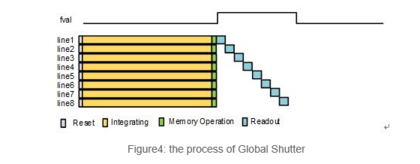
What is rolling shutter?
When the readout "wave" sweeps across the sensor in rolling shutter mode, different lines of the array are exposed at different times. Figure 5 illustrates this: the first line exposes first, followed by the second line's exposure following a readout time, and so on. As a result, after each line is read, the next one can be read. The rolling shutter only requires two transistors per pixel to transfer electrons, resulting in reduced heat generation and noise levels. The rolling shutter sensor has a simpler, less expensive structure than the global shutter sensor. But because no line is exposed simultaneously, distortion results when trying to capture fast-moving objects.
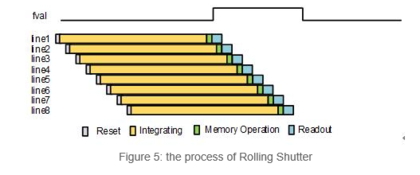
Would like our help in selecting the best rolling shutter or global camera for your project?
Please fill out the form below.
Rolling vs. global shutter scenario
The primary way that rolling shutter sensors and global shutter sensors differ in imaging is in how they acquire dynamic images.
Rolling shutter photography is prone to distortion when capturing fast-moving subjects. This can be observed in Figure 6: The left and right images depict the rolling shutter sensor and global shutter sensor, respectively, while the high-speed running fan is captured. The fan blade's shape can be precisely restored in the left image, but it is distorted in the right image.
Rolling shutter mode may result in horizontal stripes with uneven brightness when capturing objects with variations in brightness. This is depicted in figure 7 below. We are using a global shutter sensor and a rolling shutter sensor, respectively, to take pictures of indoor objects under fluorescent lights, with the exposure time set to 5ms. The background of the left image is comparatively uniform, while the right image features distinct ripples caused by the movement of water. This is because fluorescent lamps have a frequency of 50 Hz and a period of 10ms (an absolute value period). The exposure duration of 5ms has the potential to fall both in the darker and brighter ranges. Every line in the array exposes at a different time when using a rolling shutter sensor. As a result, the image had stripes that varied in brightness and darkness over time. With the global shutter sensor, there won't be any stripes because every line in the sensor starts and ends the exposure at the same time.
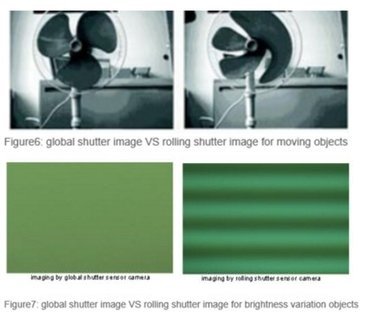
What caused the scenario?
The imaging process of a rolling shutter sensor capturing a running dog can be understood from the sequence of images that follows. The canine is sprinting from left to right. The dog's head is just entering the frame when the first line is exposed. The dog is almost out of the frame when the final line exposes. The dog is exposed in different lines, resulting in a final image that depicts a "split" dog.
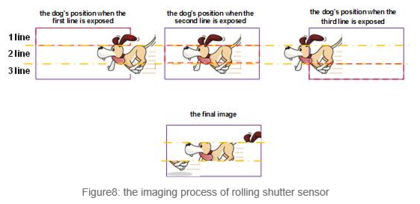
How could we avoid this?
The above-discussed issue has minimal impact on the image if the moving speed is not too fast and the brightness is changed gradually. In high-speed applications, the most basic and efficient technique is typically to use a global shutter sensor rather than a rolling shutter sensor. Nevertheless, you could use the flash to lessen the effects in some applications where money is tight or noise is an issue. When a rolling shutter sensor is required, this is also feasible.
The following is displayed in Figure 9. The flash signal that the camera emits is called a strobe. The strobe flashes when the signal is high (it also occasionally flashes when the signal is low). The image is distortion-free because every line exposes simultaneously when the strobe flashes.
When utilizing the rolling shutter sensor and sync flash feature, there are a few things to keep in mind:
- It should be noted that all lines have no overlap exposure when the exposure time is too short and the readout time is too long, even with all exposure times that have strobe signal output. The strobe does not flash, and there is no strobe signal output.
- When the exposure time is greater than the strobe flash duration
- Some strobes' performance cannot meet the high-speed switch requirement when the strobe signal output time is too short (\s level). Consequently, the strobe is unable to capture the strobe signal.
